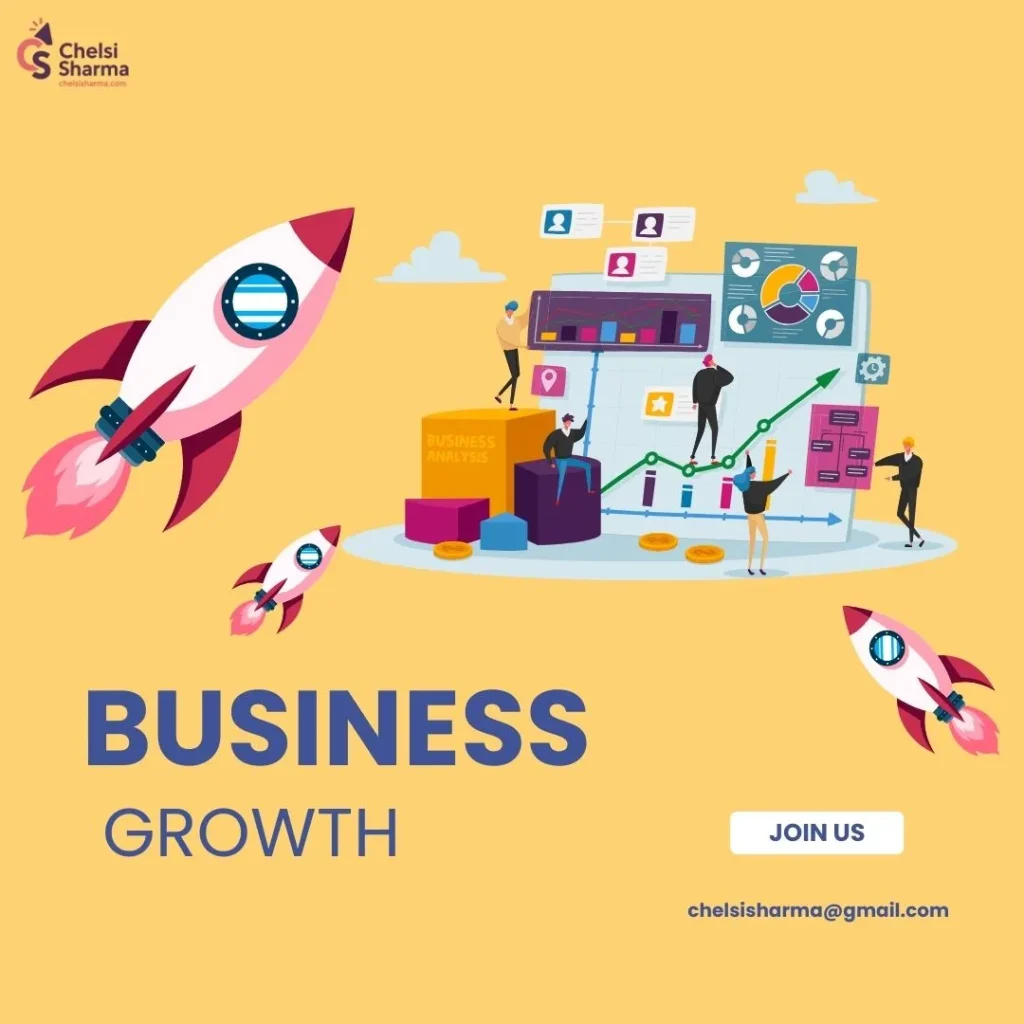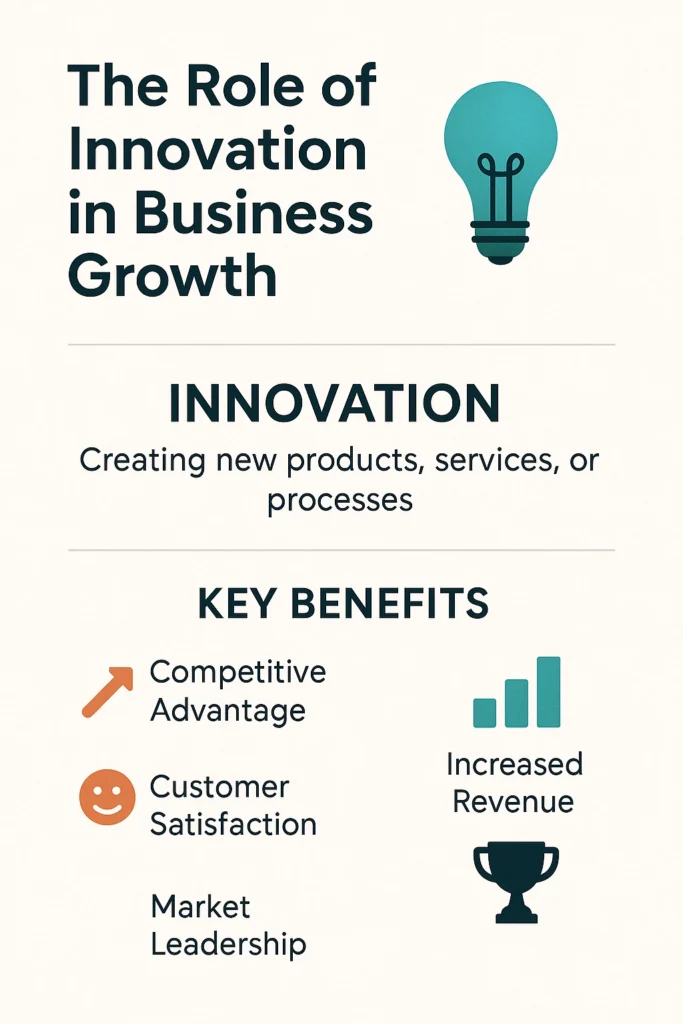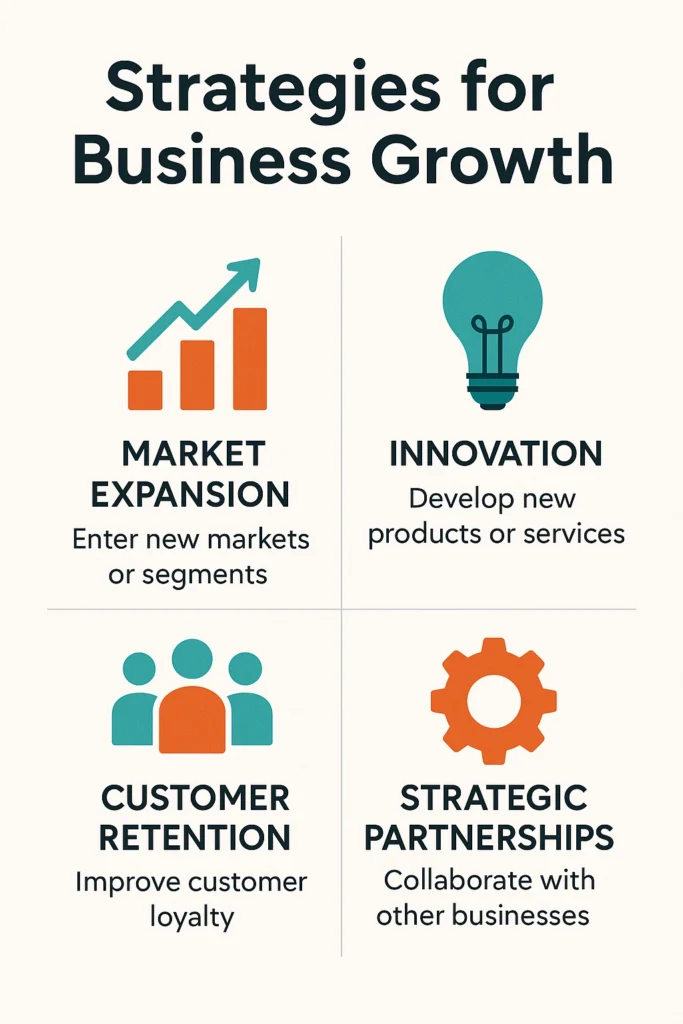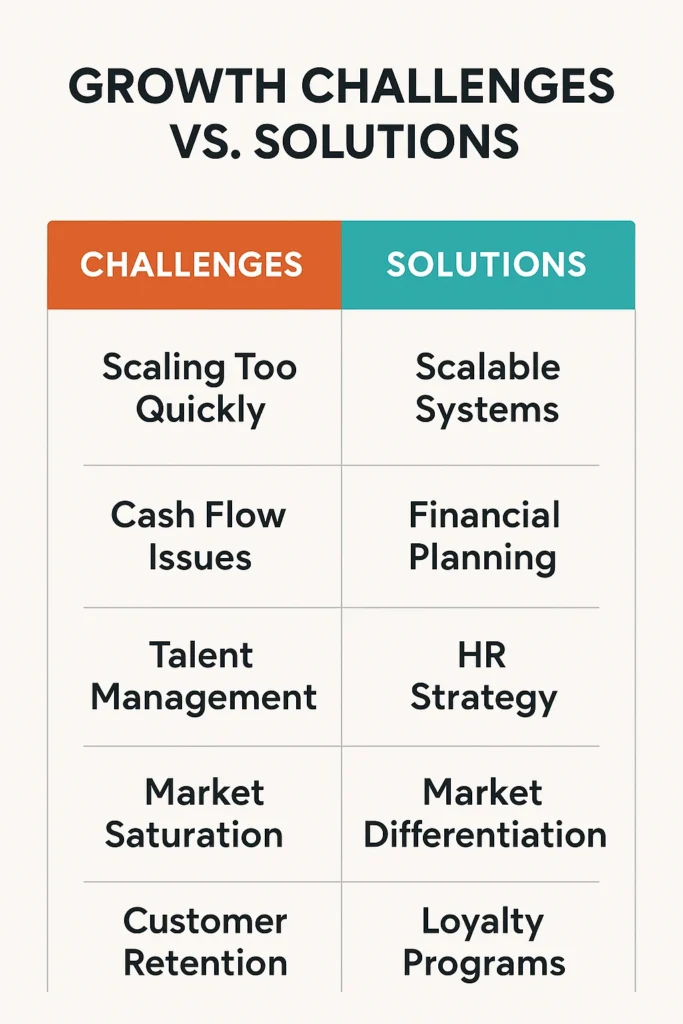
In today’s fast-paced business environment, growth isn’t just desirable—it’s vital. Without growth, even the most innovative companies risk stagnation, loss of market share, or becoming obsolete. Business growth is more than just an increase in revenue; it’s about expanding influence, value creation, customer trust, and operational maturity.
In this extensive guide, we’ll explore what business growth truly means, its various forms, strategic frameworks, challenges, and real-world examples to inspire your growth journey.
What is Business Growth?
Business growth refers to the expansion of a company in terms of revenue, customer base, product offerings, market share, or geographic reach. While revenue is the most visible indicator, real growth also involves efficiency, scalability, talent acquisition, and innovation.
Growth can be:
1. Quantitative:
Increasing revenue, number of employees, or customers.
2. Qualitative:
Improving brand reputation, product quality, or customer satisfaction.

Types of Business Growth
Understanding different types of growth helps you identify the best direction for your business:
1. Organic Growth
Achieved by increasing output, enhancing marketing, or boosting sales internally. It’s sustainable but often slower.
2. Inorganic Growth
Driven by mergers, acquisitions, or partnerships. It’s faster but comes with higher risk and integration challenges.
3. Horizontal Growth
Expansion by acquiring or developing similar products/services in new markets.
4. Vertical Growth
Expanding into different parts of the supply chain, like a retailer launching their own product brand.
5. Strategic Growth
Focused on long-term positioning and competitiveness, like entering new industries or innovating completely new product lines.
Why Business Growth Matters
Here are some core reasons why growth should be a key focus:
1. Staying Competitive:
As industries evolve, standing still means falling behind.
2. Increased Valuation:
Growing businesses are more attractive to investors and acquirers.
3. Attracting Talent:
High-growth companies attract skilled professionals looking for opportunities.
4. Resource Optimization:
Growth leads to economies of scale, reducing operational costs over time.
5. Customer Value:
Expanding allows you to serve more people and deliver greater value.
Key Drivers of Business Growth

Growth doesn’t happen randomly—it’s driven by deliberate action and focus. Here are the essential growth drivers:
1. Innovation
Product or process innovation helps businesses stay ahead. Think of Apple’s product ecosystem or Tesla’s energy tech.
2. Customer Experience
A customer-first culture creates loyalty, referrals, and long-term revenue.
3. Marketing & Branding
Powerful brands drive faster recognition and loyalty, which are critical for scaling.
4. Digital Transformation
Using tools like CRM, automation, and data analytics to streamline operations and personalize customer journeys.
5. Leadership & Vision
Strong leadership ensures that growth strategies align with the company’s mission and market realities.
Stages of Business Growth
Businesses usually go through the following growth phases:
1. Startup Phase
Focused on validating the business idea, acquiring early customers, and finding product-market fit.
2. Growth Phase
Sales increase, new markets are explored, and systems are put in place to support scaling.
3. Expansion Phase
Product lines, operations, and geographic reach expand. Teams grow, and funding may be sought.
4. Maturity Phase
The business has an established market share. Focus shifts to innovation, retention, and possibly diversification.
5. Renewal or Decline
At this point, businesses must innovate or reposition to avoid stagnation or irrelevance.
Proven Strategies for Business Growth

Below are well-established strategies businesses can adopt depending on their goals and resources:
1. Market Penetration
Selling more of your current products to existing markets using promotions, pricing, or stronger sales.
2. Market Development
Entering new markets (e.g., new cities, demographics, or industries) with current products.
3. Product Development
Creating new products for your existing customer base based on their evolving needs.
4. Diversification
Entering new markets with new products. This is riskier but can be highly rewarding.
5. Franchising or Licensing
A growth model ideal for businesses with proven, repeatable systems (e.g., food chains, education brands).
6. Strategic Alliances
Partnering with other companies to expand distribution, offer bundled services, or share tech and expertise.
Digital Marketing for Business Growth
In the digital age, growth is tightly tied to online visibility and engagement. Key digital marketing strategies include:
1. Search Engine Optimization (SEO)
Helps your business appear in search results when customers look for relevant products or services.
2. Content Marketing
Establishes your authority and builds trust with your audience. Examples: blogs, videos, whitepapers.
3. Email Marketing
One of the highest ROI channels for nurturing and converting leads.
4. Paid Advertising
Google Ads, Facebook Ads, and LinkedIn campaigns help reach highly targeted audiences quickly.
5. Social Media Marketing
Builds community and brand awareness. Influencer partnerships can also accelerate reach.
Challenges in Business Growth

Growth is exciting, but it brings its own set of hurdles:
1. Cash Flow Constraints
Expansion often requires upfront investment that stresses working capital.
2. Hiring the Right Talent
Finding people who align with your vision and culture is tough but essential.
3. Scaling Operations
Systems that worked for a small team might not scale without digital transformation or automation.
4. Maintaining Culture
As teams grow, preserving the original mission and culture becomes a leadership challenge.
5. Customer Retention
Growth often focuses on acquisition, but retention is just as critical for long-term success.
Tools & Technology for Supporting Growth
Real-Life Examples of Business Growth
Let’s take a look at some companies that mastered the art of scaling:
1. Amazon
From selling books to being the world’s largest online retailer, Amazon mastered logistics, customer obsession, and AI-driven personalization.
2. Canva
Grew by offering free tools for beginners, monetizing through pro features. Their growth is fueled by product-led development and community-driven marketing.
3. Zomato
Initially a restaurant discovery app, Zomato expanded into food delivery, cloud kitchens, and even hyperlocal advertising solutions.
4. Shopify
Built for entrepreneurs, Shopify scaled by building an ecosystem—app partners, themes, and educational content—that made starting an online business easy.
Measuring Business Growth
Growth should be tracked using clear, relevant metrics. Here are some important KPIs (Key Performance Indicators):
1. Revenue Growth Rate
Customer Lifetime Value (CLV)
Customer Acquisition Cost (CAC)
Gross Profit Margin
Market Share
Net Promoter Score (NPS)
2. Employee Retention Rate
Use dashboards to visualize this data regularly and make data-driven decisions.
Tips for Entrepreneurs and Small Businesses
1. Start with a Strong USP
What makes your business different?
2. Listen to Customers
Use feedback loops to guide product or service improvements.
3. Automate Early
Automate tasks like email, invoicing, and reporting to save time as you grow.
4. Build Relationships, Not Just Revenue
Long-term customers are more valuable than one-time buyers.
5. Invest in Learning
Stay updated with industry trends, marketing tools, and leadership techniques.
Conclusion
Business growth is not a one-time event; it’s an ongoing commitment to excellence, innovation, and value creation. The journey is complex but immensely rewarding. Whether you are in your early startup phase or looking to scale an established company, the right blend of strategy, mindset, and tools can accelerate your path to success.
Remember: Focus on building value for your customers, aligning with a clear mission, and using data to make smart, sustainable decisions.
FAQs
ABOUT THE AUTHOR
Chelsi Sharma is an aspiring digital marketer with a keen interest in helping businesses achieve sustainable growth through effective online strategies. With a focus on SEO, social media marketing, email campaigns, and performance marketing, she aims to deliver actionable insights that support startups and entrepreneurs in scaling their ventures. Currently learning through Skill Circle, Chelsi is committed to mastering the latest digital trends and applying them to real-world challenges. Through her blog, she shares practical tips, marketing tools, and growth strategies that can make a real difference for businesses at any stage. Whether you’re just starting or looking to improve your online presence, Chelsi’s content is designed to guide you every step of the way toward business success.

